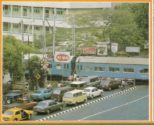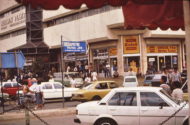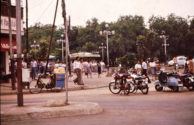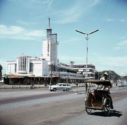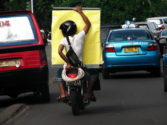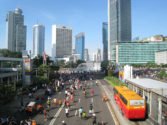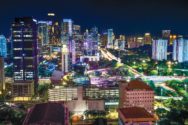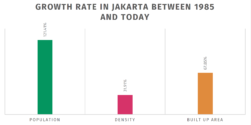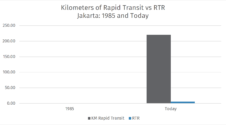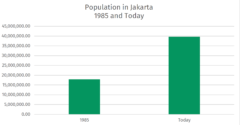
April 21, 2020
Jakarta: 1985 and Today
On the Anniversary of ITDP’s 35th Year, Transport Matters will be publishing a series of articles about cities that ITDP has worked in, comparing them from 1985 and today. The article in full can be found in the Sustainable Transport Magazine. Read previous articles about Buenos Aires here, Chennai here, Rio de Janeiro here, Dar es Salaam here, Mexico City here and Guangzhou here.
Jakarta, the capital city of the 4th most populous nation, sits on the largest in an archipelago of almost 17,000 islands. 35 years ago, Jakarta was building up at a rapid pace. 1985 saw the opening of the city’s International Airport, a culmination of a major infrastructure push that included roads and bridges for cars, but very little thought to building public transport. Jakarta’s public transport largely consisted of a few colonial-era commuter trains, with most people traveling by informal buses, cycling, and walking in a rapidly-changing city more and more dominated by cars. Today, the streets of Jakarta are packed with motorcycles and private cars, and paralyzing traffic has all but ground the city to a halt. Fortunately, the city has been making progress toward a more equitable system in the last decades.
Transjakarta opened in 2004, and, despite a host of operations problems after launch, became the city’s transit backbone, moving hundreds of thousands of Jakartans every day. Hosting the 2018 Asian Games gave the city a major incentive to rapidly improve and expand services, which it did. In the last few years, Transjakarta has revolutionized the city’s public transit – by integrating with, and formalizing the private buses that move the people of Jakarta every day, Transjakarta has grown its daily ridership to 950,000 and continues to add riders as its routes expand. Jakarta has just opened the first corridor of its Metro and has a light rail that is set to expand. Jakarta has taken efforts towards expanding sustainable transit, with enacting weekly car free days. Cycling has gained new popularity in Jakarta, as the municipal government has encouraged cycling through advocacy and education, and has begun to create a planned 63 km of cycling paths, which is planned to grow to 200 km over the next phases.
Jakarta Before
Click below photos to enlarge
Today, Jakarta is on the frontlines of climate change. With sea levels rising, the island of Java, where Jakarta is located, is under siege. Jakarta already loses $3 billion USD every year in productivity as a result of traffic, and air pollution is a major public health problem in this tropical city. Fortunately, the city’s commitment to improving the Transjakarta with a greater focus on sustainable mobility, Jakarta has the potential to become an international best practice and massively improve the lives of the 30 million people living in the Greater Jakarta Area.
Jakarta Today
Click below photos to enlarge

Jakarta in Numbers
Jakarta has grown most in population, but so has its rapid transit which did not exist in 1985. To study cities and their growth, various metrics were employed to compare global cities. Some statistics included population, built-up area, and density. Kilometers of rapid transit were measured by including those that meet the definition of BRT basics in the BRT Standard. Additionally, RTR was studied to understand how the population is served by transit. Rapid Transit to Resident Ratio (RTR) is an important metric that compares the population with the length of rapid transit lines – this number shows how well a population is served by rapid transit. In Jakarta, population more than doubled, but kilometers of rapid transit, over 200 km is not enough to increase RTR significantly. Still, Transjakarta BRT has provided Jakarta with a much needed public transit. In the next 35 years, many more changes will come to Jakarta. With hope, the successes of Transjakarta can be replicated and increased.

